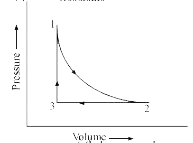Which quantity out of ΔrGandΔrGΘ will be zero at equilibrium ? Solution in Gujrati
Gibbs energy for a reaction in which all reactants and products are in standard state.
ΔrGΘ is related to the equilibrium constant of the reaction as follows :
ΔrG=ΔrGΘ+RT In k
At equilibrium, 0=ΔrGΘ+RT In k(∵ΔrG=0)
OR
ΔrGΘ=−RT In k
ΔrGΘ=0whenK=1
For all other values of K,ΔrGΘ will be non-zero.
Topper's Solved these Questions
- BOOK - KUMAR PRAKASHANCHAPTER - THERMODYNAMICSEXERCISE - Section - D Solutions of NCERT Exemplar Problems ( Matching The Columns )4videos
THERMODYNAMICS
- BOOK - KUMAR PRAKASHANCHAPTER - THERMODYNAMICSEXERCISE - Section - D Solutions of NCERT Exemplar Problems ( Assertion and Reason )3videos
THERMODYNAMICS
- BOOK - KUMAR PRAKASHANCHAPTER - THERMODYNAMICSEXERCISE - Section - D Solutions of NCERT Exemplar Problems MCQs (more than one options)5videos
THERMODYNAMICS
- BOOK - KUMAR PRAKASHANCHAPTER - THE s-BLOCK ELEMENTSEXERCISE - Section-D NCERT Exemplar Solution (Long Answer Type)8videos
THE s-BLOCK ELEMENTS
Similar Questions
Match the following :

 05:47View Solution
05:47View SolutionIn the following questions a statement of Assertion (A) followed by a statement of Reason (R) is given. Choose the correct option out of the choices given below each question.
Assertion (A): Combustion of all organic compounds is an exothermic reaction.
Reason (R) : The enthalpies of all elements in their standard state are zero.View SolutionThermodynamics mainly deals with
View SolutionThe s-block elements are characterised by their larger atomic sizes, lower ionisation enthalpies, invariable +1 oxidation state and solubilities of their oxosalts. In the light of these features describe the nature of their oxides, halides and oxosalts.
01:34View SolutionThe temperature dependence of equilibrium constant of a reaction is given by In K_(eq) = 4.8 -(2059)/(T) . Find Delta_(r)G^(Theta), Delta_(r)H^(Theta), Delta_(r)S^(Theta) .
01:35View SolutionStandard Gibbs energy of reaction (Delta_(r)G^(@)) at a certain temperature can be completed as Delta_(r)G^(@)=Delta_(r)H^(@)-Tdelta_(r)S^(@) and the change in the value of Delta_(r)H^(@) and Delta_(r)S^(@) for a reaction with temperature can be computed as follows: Delta _(r) H_(T_(2))^(@)-Delta_(r)C_(p)^(@)(T_(2)-T_(1)) Delta_(r)S_(T_(2))^(@)-Delta_(r)S_(T_(1))^(@)=Delta_(r)C_(p)^(@)In ((T_(2))/(T_(2))) Delta_(r)G^(@)=Delta_(r)H^(@)-T.Delta_(r)S^(@) Delta_(r)^(@)G^(@)=-RTInK_(eq) Consider the following reaction : CO(g)+2H_(2)(g)toCH_(3)OH(g) Given Delta_(r)H^(@)(CH_(3)Oh,g]=-201KJ//mol Delta_(r)H^(@)(CO,g)=-114KJ//mol s^(@)(CH_(3)OH,g)=240J//mol-k, S^(@)(H_(2)g)=198J//mol-K C_(p.m)^(@)(h_(2))=28.8JK^(-1)mol^(-1) C_(p.m(CO)=29.4J//mol-K C_(p.m)^(@)(CH_(3_)OH)=44J//mol-K and In ((320)/(300))=0.06,"all data at"300K. Delta_(r)S^(@) at 300 K for the reaction is :
02:03View SolutionStandard Gibbs energy of reaction (ΔrG∘) at a certain temperature can be completed as ΔrG∘=ΔrH∘−TδrS∘ and the change in the value of ΔrH∘ and ΔrS∘ for a reaction with temperature can be computed as follows:
ΔrH∘T2−ΔrC∘p(T2−T1)
ΔrS∘T2−ΔrS∘T1=ΔrC∘pIn(T2T2)
ΔrG∘=ΔrH∘−T.ΔrS∘
Δ∘rG∘=−RTInKeq
Consider the following reaction :
CO(g)+2H2(g)→CH3OH(g)
Given
ΔrH∘(CH3Oh,g]=−201KJ/mol
ΔrH∘(CO,g)=−114KJ/mol
s∘(CH3OH,g)=240J/mol−k,
S∘(H2g)=198J/mol−K
C∘p.m(h2)=28.8JK−1mol−1
Cp.m(CO)=29.4J/mol−K
C∘p.m(CH3□OH)=44J/mol−K
andIn(320300)=0.06,all data at300K.
Δrs∘ at 320K is:02:58View SolutionWhich quantity out of Delta_(r)G " and " Delta_(r) G^(Θ) will be zero at equilibrium ?
View SolutionFor the hypothetical reaction A_(2)(g) + B_(2)(g) hArr 2AB(g) If Delta_(r)G^(@) and Delta_(r)S^(@) are 20 JK^(-1)mol^(-1) respectively at 200 K. Delta_(r)C_(p) is 20 JK^(-1) mol^(-1) then Delta_(r)H^(@) "at" 400 K is :
04:12View SolutionWhich quantity out of Delta_(r)G and Delta_(r)G^(c-) will be zero at equilibrium ?
03:08View SolutionThe standard heat of formation of at 298 K for Cl4(g),H2O(g),CO2(g)andHCI(g) are -25.5, -57.8, -94.1 and -22.1 kcal mol−1 respectively. Calculate ΔrHΘ for the reaction
rCl4(g)+2H2O(g)→CO2(g)+4HCl(g)
Hint : ΔrHΘ=∑ΔfHΘProducts−∑ΔfHΘReactants03:15View SolutionIn view of the signs of ΔrG∘ for the following reactions:
PbO2+Pb→2PbO,ΔrG∘
SnO2+S→2SnO,ΔrG∘
Which oxidation states are more characteristics for lead and tin?02:03View Solutionसाम्यावस्था पर ΔrG तथा ΔrG∘ में से कौन-सी राशि का मान शून्य होगा ?
01:34View Solution(a) A sample of 1.0 mol of a monoatomic ideal gas is taken through a cyclic process of expansion and compression as shown in figure. What will be the value of ΔH for the cycle as a whole?
(b) Which quantity out of ΔrG and ΔrGΘ will be zero at equilibrium?
 03:42View Solution
03:42View SolutionIn view of the signs of Delta_(r)G^(@) for the following reactions : PbO_(2)+Pbto2PbO,Delta_(r)G^(@)lt0 SnO_(2)+Snto2SnO,Delta_(r)G^(@)gt0 , which oxidation states are more characteristic for lead and tin ?
02:32View Solution

